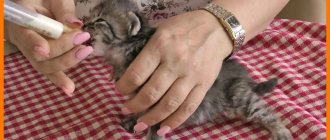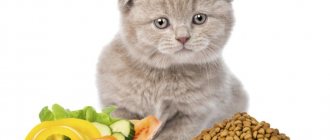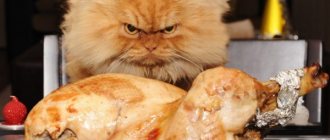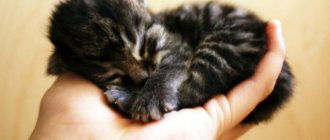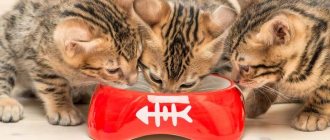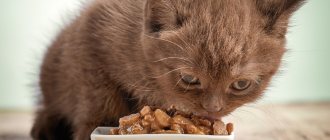6930Administration
When a new meowing pet appears in the family, the questions naturally arise: “What to feed the kitten? How many times a day? What portions should I feed the kitten? Of course, there will be no uncertainty about the choice of diet if the animal is taken from a responsible breeder who explained in detail all the nuances of upbringing and maintenance.
What to do if a fluffy is found on the street or born from your own cat? Or are you a breeder yourself who needs to prepare your baby for adulthood? The recommendations below will help you quickly solve the problem and teach you how to properly feed small kittens.
At 1 month
Below we will look at how and what to feed a 1 month old kitten at home:
- dry mixtures (sold in pet departments);
- fermented milk products (with low fat content and without sugar);
- goat milk (dilution with water is appropriate: 1:1);
- liquid porridge (semolina or rice, preferably crushed);
- yolk (boiled, mixed with low-fat cottage cheese; allowed 2 times every 7 days);
- puree for children: meat or fish;
- soup (low-fat meat + broth, no need to salt it. Allowed once every 7 days);
- fish (sea fish, boneless fillets are best. Give 2 times every 7 days).
Allowed foods are introduced into the kitten’s menu gradually so that the baby gets used to the new diet. If you do not take this into account, the baby may develop diarrhea, indigestion, and what’s even worse, the kitten may die.
How to feed a one-month-old kitten
Newborn kittens rarely drink water, but they need liquid nutrition (take 10% fat cream - you definitely can’t go wrong). There should always be a bowl of clean water next to your food, which needs to be changed regularly. Make it a rule to wash his bowl after every meal, cats are clean creatures, your kitten will not like a dirty bowl. It is best to take not plastic, but metal.
Up to 1 month, feed the kitten 8 times a day. The number of meals is gradually reduced as the pet gets older. If the baby refuses to eat, do not delay visiting the veterinarian.
At the age of 4 months, give the kitten 50g. food at a time (per 100 g of weight). The normal weight of a small kitten is 200 g; 100 g of food per day will be enough for him.
Can I have milk?
Veterinarians advise giving the kitten instant powder (instead of milk). Cow's milk, which contains lactose, is not the best food for your pet. The powder is sold in any pet department. After 1 month, feed the kitten milk 2 times a day. If you have adopted a kitten that is accustomed to milk, give it a product in porridge form that contains lactose.
You can feed your pet:
- fermented baked milk;
- sour cream.
These products contain many useful substances and cats love them.
Getting used to solid food
Young kittens are gradually introduced to solid food. Veterinarians advise taking into account the kitten’s nutrition: if you plan to feed it meat, you can cut small pieces of fillet and add them to the broth; if the baby eats liquid porridge, you can gradually dilute it and add more solid foods, for example, cereal.
While kittens readily eat meat, not all of them appreciate vegetables. A kitten accustomed to liquid food will have a harder time getting used to solid food - stay nearby and supervise your pet’s nutrition.
If your pet leaves pieces of solid food in the bowl, grind them in a blender or chop them as finely as possible.
Products recommended for nutrition
The first solid food should be soft. You can't give your kitten a piece of fish - he just won't be able to eat it. You can mix raw yolk with dairy products. If you decide to cook it, mix it with milk. Some owners add vegetable oil (without this, the baby may choke, as they believe).
What natural foods to feed your cat to make her gain weight
When fattening, you should avoid too fatty foods (pork, lard, cream) and feeding from the human table. Such food worsens the functionality of the gastrointestinal tract, causing new complications.
The main emphasis should be on calorie content, choosing foods with high energy value. It is recommended to include in the menu:
- chicken, rabbit, lamb and veal, containing large amounts of animal protein;
- boiled vegetables (zucchini, pumpkin, carrots), bran and oatmeal, enriched with fiber;
- sea fish, offal, chicken and quail yolks, characterized by a wide variety of vitamins and minerals in their composition;
- fermented milk products with low fat content, which have a beneficial effect on the functioning of the cardiovascular system and the musculoskeletal system;
- jellied cartilage, containing collagen beneficial for joints;
- buckwheat and rice porridge, which normalize peristalsis and digestion.
Instead of milk, it is better to use artificial milk formulas from a pet store. Otherwise, your pet may have digestive problems.
At 1.5 months
Below we will consider how and what to feed a 1.5 month old kitten at home:
At this age, the pet can already feed on its own, and its diet should be balanced. At this age, the kitten can be fed:
- rolled oats and buckwheat porridges;
- vegetables (any vegetables, except potatoes, served boiled or raw);
- raw meat (low-fat varieties). Served raw, boiled or scalded with boiling water. Meat products make up from 60 to 80% of the total daily food volume.;
- boiled offal;
- cottage cheese - 30 g per day, preferably not fatty;
- raw fish, previously doused with boiling water (about 1 time every 7 days);
- greens (you can ask at the animal department).
How often should I feed?
Kids eat a lot, 5-6 meals a day is the norm. In general, a kitten should eat 120 g per day. The baby cannot eat this amount at once. If the kitten eats less than normal, then you should try changing the food. If the animal refuses food, it is better to contact a veterinarian.
Once the kitten reaches 2 months, you can feed it a little more - up to 180 g. At this point, it is important to monitor the pet’s activity - more playful and active ones need more food.
If you are going away for the day and leaving your kitten alone, feed him before you leave and leave some food in his bowl and feed him more when you return.
Food additives
Do not neglect this important point - vitamins and supplements will have a beneficial effect on the kitten’s body.
From 1.5 months you can add to food:
- Kitzim;
- "Doctor Zoo";
- "Brevers";
- "Farmavit";
- "Biofar".
Before purchasing vitamins, consult with specialists. Veterinarians can advise you on which food supplements are best for your pet and whether your pet needs them at all. The most popular supplement for cats is fish oil. Veterinarians advise giving it 2 capsules for 7 days.
What not to give to a kitten
Every caring owner should remember the list of prohibited foods. Kittens should not eat:
- food with spices (the kind that people like);
- fatty meat: pork, beef;
- human medicines;
- sweets;
- river fish;
- legumes;
- fatty dairy products;
- flour;
- potatoes.
Is it possible to have ready-made food at 1.5 months?
Cat owners and veterinarians do not recommend mixing food and natural food. Many people primarily purchase ready-made cat food for a number of reasons:
- saving time;
- nutritional balance.
If you want to feed your pet food, you should consider that:
- it will not be possible to switch to natural nutrition;
- You cannot mix food of different brands, as they contain different microelements;
- Only high-quality commercial feed is suitable for feeding.
Choose high-quality, balanced food and your kitten will not have any health problems.
Kittens love wet food, but it's a little more expensive. However, according to veterinarians, dry, high-quality ones are more useful.
It is worth noting that wet food contains about 80% water, and your pet does not need to constantly drink water. With dry food, everything is different - there should always be a clean bowl with drinking clean water near the food bowl.
Veterinarians consider the following brands to be good food:
- Royal Canin;
- Almo Nature;
- Pro Plan Junior;
- Eukanuba Puppy Kitten.
The price tag may scare the kitten's owners, but believe me, by purchasing good food, you only win. You won’t have to buy additional vitamins, and the kitten will be healthy, and you won’t have to spend money on treatment.
Homemade food or store-bought kitten food?
Arguing about which diet is best for a growing body is a thankless task. There will be plenty of supporters of feeding homemade food, as well as opponents. Both methods of eating have a number of advantages and disadvantages, for example, cooking at home will cost less than buying specialized food, but will the owner dare to cook every day? Those who advocate for home-cooked food are stopped by the price of store-bought quality food. What to feed small cats and cats is decided by each owner, based on his own ideas and income.
- Popular foods
- New
- Stock
Proplan pouch for kittens pieces in jelly CHICKEN
Proplan Pouch for kittens pieces in jelly CHICKEN Delight your pet with the new Pro Plan® wet food in soft packaging! Our team of nutrition experts has developed…
Price: from 61
GO grain-free food for kittens and cats with sensitive digestion with fresh duck
GO grain-free food for kittens and cats with sensitive digestion with fresh duck
Price: from 1320
Monge Cat Grill Pouch for kittens Norwegian salmon
Monge Cat Grill Pouch pouches for kittens Norwegian salmon Complete canned food pieces in jelly with Norwegian salmon for kittens. Ingredients: meat and meat by-products (fresh...
Price: from 64
Dry food GO (Go) for kittens and cats with salmon and cod
Dry food GO (Go) for kittens and cats with salmon and cod
Price: from 1227
Monge Cat Monoprotein Chicken Meat Flakes for Cats
Monge Cat Monoprotein Chicken Meat Flakes for Cats Chicken Flakes. A complete diet for adult cats. Nutritional value: crude protein (12.5%), crude fiber (0.4%),…
Price: from 110
Hill's food for senior dogs from 7 years old SP Canine MA7+ Savory Chicken
Hill's food for senior dogs from 7 years SP Canine MA7+ Savory Chicken Recommended for: - dogs 7 years and older. Not recommended for: - Cats - Puppies - Pregnant and lactating...
Price: from 2568
Monge Dog BWild GRAIN FREE grain-free canned turkey with pumpkin and squash for adult dogs of all breeds
Monge Dog BWild GRAIN FREE grain-free canned turkey with pumpkin and zucchini for adult dogs of all breeds Monge Dog BWild Grain Free canned turkey with pumpkin and zucchini for dogs of all breeds 400 is a balanced diet for…
Price: from 149
Berkeley Canned Food No. 7 Turkey with Cheese for Cats
Berkeley Canned Food No. 7 Turkey with Cheese for Cats Complete canned food for kittens. Tender chicken of the best quality with rice, salmon oil and aromatic...
Price: from 86
Monge Dog BWild GRAIN FREE grain-free duck food with potatoes for puppies of all breeds
Monge Dog BWild GRAIN FREE grain-free food from duck meat with potatoes for puppies of all breeds Complete food for puppies of all breeds with duck and potatoes does not contain grains, 2.5 kg The appearance of the BWild Grain food line…
Price: from 1750
Monge Dog Grill Pouch for dogs lamb with vegetables
Monge Dog Grill Pouch pouches for dogs lamb with vegetables Monge Dog Grill Pouch pouches for dogs lamb with vegetables 100 g Wet food with lamb and vegetables. A complete balanced diet...
Price: from 61
Proplan pouch canned food for neutered cats - pieces in sauce with CHICKEN
Proplan pouch canned food for neutered cats - pieces in sauce with CHICKEN Pro Plan Sterilized supports the health of the urinary system of sterilized cats and neutered cats promotes…
Price: from 61
Royal Canin Neutered Adult Dry food for adult spayed/neutered dogs over 12 months
Royal Canin Neutered Adult Dry food for adult spayed/neutered dogs over 12 months Complete dry food for adult (over 12 months) sterilized males/females of medium size (weighing from 11 to 25 kg) with…
Price: from 1592
ALL FOOD FOR KITTENS
Perhaps expert advice will help you find the right solution:
- Consider financial possibilities: it makes sense to switch to a home cooking method if good specialized nutrition is expensive.
- Buying cheap food simply means harming your small pet; The composition of ready-made food advertised on TV is distinguished by the abundance of vegetables, meat and bone meal, and the addition of flavoring additives that are so attractive to cats. An unhealthy composition will result in problems with health and well-being.
- Kitten food is an ideal solution if the owner works a lot, stays late, is tired and does not have the strength to prepare a delicious dinner for the baby; take out the bag and you're done.
- Natural products are undoubtedly healthier than store-bought cat food. When choosing a method of feeding homemade food, remember: you will have to prepare a variety of dishes to cover your pet’s daily need for microelements. Make up for the deficiency with vitamin supplements. This incurs certain financial costs, but the finished pates and granules are balanced, the composition has the necessary substances for growth and harmonious development.
- A diet based on meat and cereals is ideal for a growing body. Physiologically, the intestines of animals are adapted to process hard protein foods, so soft foods (pates) become a common cause of constipation and diarrhea.
Features of feeding cats of different breeds
There are no main differences in food; cats are predators; periodically all breeds are given meat or fish. But there are minor differences: for example, British Shorthairs are fed nutritious food - they grow quickly and need more abundant nutrition. Russian blue cats should not be given liver, and the Maine Coon needs plentiful and dense nutrition (the main thing is not to overfeed).
How much does a kitten weigh?
Gradual and sufficient weight gain is the main indicator of proper development. If you know the age and breed of the kitten, just weigh it on the scale.
It is advisable to weigh kittens weighing up to 1 kg on electronic kitchen scales that have a small error. To do this, use either a special container that comes with the scales, or a suitable plastic container.
Larger pets can also be weighed on household floor scales. As a last resort, you can weigh yourself, and then with your pet in your arms - and calculate the difference.
It is believed that until the age of six months, a kitten gains, on average, 100 grams of weight per week. After 6 months, the growth of a kitten of most breeds almost stops, but the weight continues to increase due to an increase in muscle mass.
However, there are breed characteristics - for example, Maine Coons grow very slowly and only by two years, or even later, gain their final weight and height. So for more accurate information, it is better to contact the breeder or a specialized website for the breed.
Here is a table showing the approximate weight parameters of kittens of different breeds by month. You can focus on it when determining the norm of development of a kitten.
Kitten weight table
| Development of kittens in the first year of life | ||||||
| Age | Weight of cats, g | Cats weight, g | ||||
| average | big | very large | average | big | very large | |
| 4 weeks | 550 | 630 | 820 | 450 | 560 | 740 |
| 6-8 weeks | 1000 | 1230 | 1500 | 900 | 1150 | 1400 |
| 10-12 weeks | 1350 | 1800 | 2300 | 1200 | 1700 | 2300 |
| 14-16 weeks | 1700 | 2700 | 3800 | 1500 | 2600 | 3600 |
| 5 months | 2050 | 3200 | 5500 | 1800 | 2900 | 4300 |
| 6 months | 2400 | 3900 | 6000 | 2100 | 3200 | 4500 |
| 7 months | 2750 | 4200 | 6500 | 2400 | 3500 | 4900 |
| 8 months | 3100 | 4500 | 6900 | 2700 | 3800 | 5200 |
| 9 months | 3450 | 5000 | 7000 | 3000 | 4100 | 5500 |
| 10 months | 3800 | 5200 | 7700 | 3200 | 4200 | 5800 |
| 11 months | 4050 | 2600 | 8000 | 3350 | 4300 | 6100 |
| 12 months | 4500 | 5700 | 9000 | 3500 | 4500 | 6800 |
| 18 months | 6000 | 9500 | 4700 | 7000 | ||
Frequency of feeding kittens depending on age
- In the first 14 days of life - 10 meals;
- From two weeks to one month, reduced to 8 meals;
- By two months they switch to feeding 7 times a day;
- From the 2nd to the 3rd month they feed 6 times;
- From 4 to 5 – 5 times; From 5 to 9 – 4 times;
- From 9 to 12 – 3 times;
- After a year they switch to two feedings a day.
Little kittens still drink the milk of their mother cat, and what kind of complementary feeding you organize for them depends on your wishes. If complementary feeding consists of natural food, continue to feed it; if it’s food, then food. Do not mix 2 different types of food, this is incorrect and can harm your pet's health.
Products undesirable for kittens
Despite the fact that 20 years ago in villages cats were fed leftovers from dinner, and the animals did not have any problems with nutrition, modern pets have a more sensitive digestive tract.
In addition, they live in different conditions, and their immunity is not adapted to survive extreme situations. That is why it is better to exclude the following products from the animal’s diet:
- sausages, sausages, smoked meats;
- rice;
- bread and buns;
- margarine and butter;
- pasta;
- mushrooms and legumes;
- tomatoes;
- sweets.
Of course, nothing will happen to the kitten from one piece, but systematic consumption of such products will shorten the pet’s lifespan.
Dangerous foods for kittens
It is important to eliminate raw foods from your diet whenever possible. This is especially true for pork and river fish - they contain a lot of worms. It is better to boil and chop these products or replace them with lean meat and sea fish. You should also avoid seafood (shrimp, mussels).
Extremely dangerous products
Chocolate is very dangerous even for adult cats. Its consumption can cause the death of the animal. This product contains theobromine, which is absolutely not excreted from the cat’s body and accumulates in dangerous concentrations. The same applies to large bones, fragments of which can injure internal organs. It is strictly forbidden to give kittens expired food and medications prescribed for humans.
Also, depending on the breed, there may be certain dietary restrictions. For example, Maine Coons do not really like fish and digest it poorly, and Sphynx cats should not be given fatty foods.
Useful video
Get to know interesting cat breeds with the help of our encyclopedia: Burmese, Himalayan, Javan.
Similar
What grass do cats eat and why?
What not to feed cats
Is it possible to combine raw and cooked meat?
Why do experts insist that raw and cooked meat should not be combined? As an argument, they cite the fact that in the process of digesting thermally processed and raw meat, completely different enzyme groups are involved. Thus, the process of digesting food with different cooking methods can be difficult.
Raw meat should not be offered to a cat at the same time as cooked meat.
